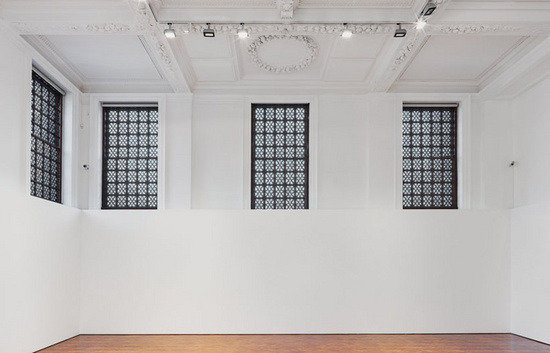Trade Routes
dal 1/5/2013 al 26/7/2013
Segnalato da
Adel Abidin
Fatima Al Qadiri
Khalid al Gharaballi
Alighiero Boetti
Monir Farmanfarmaian
Subodh Gupta
Gulsun Karamustafa
Bharti Kher
Rachid Koraichi
Lee Xe
Maha
Malluh
Bettina Pousttchi
Hassan Sharif
Wael Shawky
David Zink Yi
1/5/2013
Trade Routes
Hauser & Wirth, London
The exhibition features video installations, sculptures and two-dimensional works by artists based in Africa, China, Europe, India, and the Middle East including Adel Abidin, Fatima Al Qadiri & Khalid al Gharaballi, Alighiero Boetti, Monir Farmanfarmaian, Subodh Gupta...

Trade routes have connected the major centres of civilisation in Europe and Asia
since antiquity. These routes not only made the exchange of goods possible, but
also fostered cultural exchanges between distant regions. The group exhibition,
'Trade Routes', on view at Hauser & Wirth's Piccadilly gallery from 3 May, presents
a diverse picture of where these trade routes stand in today's globalised society
through the lens of 15 artists.
The exhibition features video installations, sculptures and two-dimensional works
by artists based in Africa, China, Europe, India, and the Middle East including Adel
Abidin, Fatima Al Qadiri & Khalid al Gharaballi, Alighiero Boetti, Monir Farmanfarmaian,
Subodh Gupta, Gülsün Karamustafa, Bharti Kher, Rachid Koraïchi, Lee Xe, Maha
Malluh, Bettina Pousttchi, Hassan Sharif, Wael Shawky and David Zink Yi.
German artist Bettina Pousttchi broadens the previously conceived notions of her
medium by bringing together architecture and sculpture in her photography. For ‘Trade
Routes’, Pousttchi has created a new photo installation entitled 'Piccadilly Windows'.
Pousttchi uses a selection of photographs of structural elements from renovated timber-
frame houses taken near her hometown and then re-works these into a pattern that
recalls traditional architectural elements of the Middle East. The resulting motifs are
applied directly to the nine windows of the main gallery. With this subtle intervention
combining an archetypal example of Western European architecture with traditionally
Middle Eastern architectural ornamentation, Pousttchi makes a transnational gesture
that investigates the cultural dimensions of architecture.
Rachid Koraïchi and Monir Farmanfarmaian,
based in Algeria and Iran respectively, have
adapted traditional techniques from their
native countries and integrated these into
their practice. Koraïchi's tapestries are
suspended from the main gallery's ceiling,
hanging just above the heads of visitors.
The tapestries chronicle the lives of 14
great mystics of Islam, such as the poet
Rumi, whose writings the artist believes are
just as relevant in today's society as they
were in the 13th century. The tapestries are
covered in ornate Arabic calligraphy and
ciphers from a range of other cultures, as
well as symbols imagined by the artist.
Monir Farmanfarmaian's large-scale mirror
installations combine two elements from
traditional Islamic design: mirror mosaic
and reverse glass painting. Her techniques,
which are traditionally passed down from
father to son, create kaleidoscopic and
intricate avant-garde patterns that catch
and refract the light in the room.
The video works of Adel Abidin and Fatima Al Qadiri & Khalid al Gharaballi address the
contradictions implicit in the social and cultural constructs of contemporary society.
Adel Abidin's three channel video installation 'Three Love Songs' will fill the American
Room with films of sultry and seductive blonde women serenading the viewer with what
initially seems to be poetic ballads sung in an Iraqi dialect of Arabic. However, these
songs are actually odes dedicated to the former leader of Iraq, Saddam Hussein. With
'Three Love Songs', Abidin brings to the forefront the underlying cultural friction and
political tension by creating an uncomfortable juxtaposition between the sexualised
performance, replete with Western clichés, and the meaning of the lyrics.
Fatima Al Qadiri & Khalid al Gharaballi's film 'Mendeel Um A7mad (NxIxSxM)' recreates
the Kuwaiti ritual of Chai Dhaha, a meeting of women for pre-noon tea. However, in Al
Qadiri & al Gharaballi's version of the long-standing tradition, the middle-aged women
are all played by a cast of young men and, instead of an intimate, residential setting,
the film is set in a vast, opulent hotel ballroom, with each character sitting far away
from the others. A small,
bright pink tissue box –
commonplace in every
Kuwaiti household – sits
on its own in the middle
of the ballroom, far
away from the women
who might need them.
The film is a satirical
depiction of upper-
class Kuwaiti social
interactions, highlighting
the absurdity of ritualised
communications and shattering the
sense of familiarity one would expect at a
gathering of close friends and family.
'Trade Routes' will also feature sculpture
and two-dimensional works by Subodh
Gupta, Maha Malluh, and Hassan Sharif.
These artists explore notions of cultural
displacement through the use of found
and kitsch objects, such as flipflops, as
in Sharif's seemingly imbalanced tower,
cassette tapes of religious lectures, as
in Maha Malluh's installation or Subodh
Gupta's suitcases, sleeping bags and
cardboard boxes, cast in aluminium.
Opening: Thursday 2 May 6 – 8 pm
Hauser & Wirth Outdoor Sculpture
Southwood Garden
St James's Church, 197 Piccadilly - London W1J 9LL
Gallery hours: 10 am - 6 pm daily
Admission free



